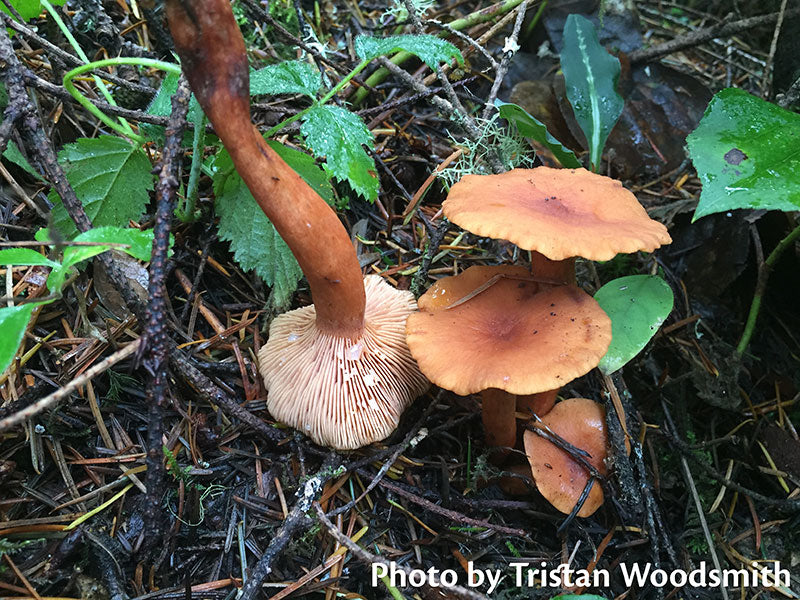
Mushrooms for Dessert?
Here at Fungi Perfecti, we love all edible mushrooms, not only those you can cultivate. So when we aren’t busy inoculating mushroom kits or researching new and innovative uses for fungi, many of us go hunting for the mushrooms we cannot grow.
A locally common and deliciously fragrant mushroom is Lactarius rubidus, also known as the Candy Cap. These mysterious mushrooms are mycorrhizal partners of our Douglas fir, spruce and other trees, and can be found scattered on rotting conifer wood late in the season (usually November). Although the range of L. rubidus is limited to Washington, Oregon and California, you can find Lactarius fragilis in the Eastern US and Lactaruis camphoratus in parts of Europe. These three species are all considered “Candy Caps” by those who seek them.
Candy Caps are members of the genus Lactarius, or Milk Caps, named for the white, orange or red latex they exude from special cells embedded in the mushroom flesh. When the flesh of a young Lactarius is cut, it releases this latex – a useful characteristic for identification. Mycologists think that this might protect young mushrooms from predation. Candy Cap mushrooms exude whitish latex when damaged that is watery to whey-like in viscosity (see photo above). Although individual Candy Caps are small in stature, they tend to fruit in large numbers, so it is not difficult to collect a significant amount in one foray.
Once dried, these mushrooms take on a strong caramel or maple syrup odor, which can last for years. According to the mycology site MykoWeb, dried herbarium material of Lactarius fragilis retained its odor even after 64 years in storage!
Recently, the chemical responsible for the distinct odor of L. rubidus was isolated by William Wood, who found that as the mushrooms dry, amino acids combine to form “quabalactone III.” This then combines with water (via hydrolysis) to form “sotolon” – the chemical responsible for the odor. Sotolon is naturally found in molasses, aged rum and roast tobacco, and is synthesized for use as a component of imitation maple syrup and other artificial flavors. Oddly enough, the odor can be perceived either as caramel or maple syrup at lower concentrations, or as curry or fenugreek as the concentration increases.
The following poem, courtesy of our own Loni Jean Ronnebaum, can be helpful in remembering the identification characteristics of Candy Caps:
“Surface dry, never viscid
Cap and stem, color consistent
Hairy stem base, hollow in age
Light white latex, no yellow stain
Wrinkled/uneven cap it might
Spores are light, yellow to white”
Small Lactarius mushrooms might be mistaken for LBMs ("Little Brown Mushrooms”) or deadly Galerinas by inexperienced mushroom hunters. They can be distinguished by their stem, which crushes easily – unlike the more flexible stems of other types of mushrooms – and presence of latex. They differ from other non-edible Lactarius by the color of the latex, and mild to sweet flavor (lacking a bitter or acrid taste). As always, we recommend consulting a field guide and carefully identifying each mushroom prior to consuming. A good field guide that mentions Candy Caps is All That The Rain Promises and More by David Arora.
